When you buy through our links, we may earn a commission. Products or services may be offered by an affiliated entity. Learn more.
Your bedroom should be a place to unwind and relax, but it can also be a source of allergens. Some mattresses can harbor dust mites, pet dander, mold, and mildew, which often cause nasal congestion, sneezing, watery eyes, a runny nose, and coughing. The solution, at least in part, is investing in a hypoallergenic mattress.
Our Top Picks
-
Best Mattress Overall – Helix Midnight Luxe
View Details
-
Best Foam Mattress – Layla Memory Foam Mattress
View Details
-
Best Value Mattress – DreamCloud Classic Hybrid
View Details
-
Best Luxury Mattress – Zenhaven
View Details
-
Best Mattress for Back Pain – WinkBeds EcoCloud
View Details
-
Best Mattress for Side Sleepers – Nolah Natural 11
View Details
-
Best Mattress for Couples – Bear Elite Hybrid
View Details
-
Best Organic Mattress – Birch Mattress
View Details
Swipe for more
Best Mattress Overall
Helix Midnight Luxe
9.7 /10
Test Lab Score
25% off sitewide
25% off sitewide
Our top pick for the best overall mattress for people with allergies is the Helix Midnight Luxe. Its foam layers not only resist allergens but also provide essential cushioning to help a wide range of sleepers get effective support throughout the night.
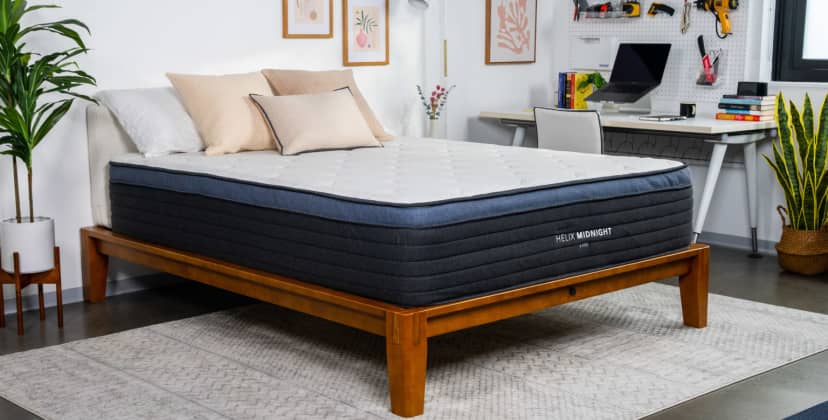
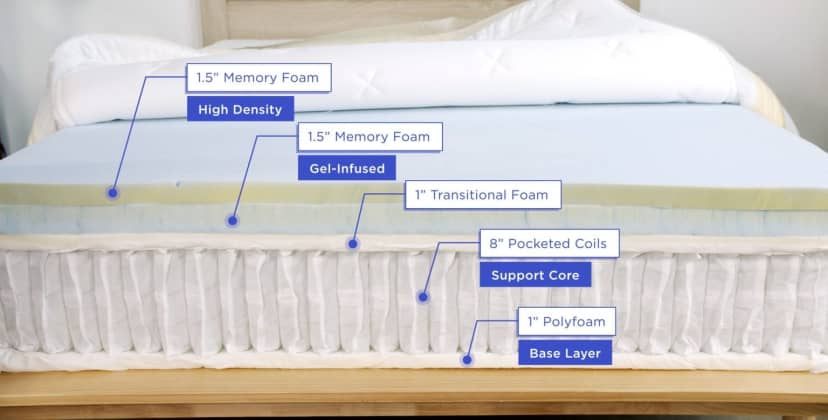
Credit: Sleep Foundation Test Lab
Price
$1,799
Mattress Type
Hybrid
Firmness Options
Medium Firm (6)
Trial Period
120 nights (30-night requirement)
At a Glance
- Who It’s Best For: Back and side sleepers weighing up to 230 pounds. Couples can also benefit.
- Feel: Even, balanced, medium-firm (6) feel. Lightly embraces heaviest pressure points but doesn’t buckle, bend, or sag.
- What It’s Made Of: Top two layers are memory foam, followed by transitional polyfoam. The coil-based support core enables airflow.
- What We Don’t Like: Too soft for sleepers over 230 pounds, particularly stomach sleepers.
Scoring Breakdown
The following ratings show how suitable this mattress is for different sleeping positions and sleeper weights. These scores are determined by how well the mattress supports and relieves pressure for each sleeper type.
We performed a meta-analysis on 5876 validated customer reviews of the Helix Midnight Luxe. This is what people who bought the mattress had to say:- Comfort and Support: Many reviewers express that the mattress provides exceptional comfort and support, especially noting its ability to alleviate back, hip, and shoulder pain.
- Sleep Quality Improvement: The mattress is frequently described as transformative for those who previously struggled with sleep disturbances.
- Temperature Regulation: Positive remarks are made about the cooling properties of the mattress. Users find the cooling aspect effective, helping to maintain a comfortable sleeping temperature throughout the night.
- Customer Service: Experiences with customer service are predominantly positive, with buyers appreciating the responsive and helpful nature of the support team. Issues are resolved satisfactorily, contributing to a positive overall customer experience.
- Durability Concerns: A few reviewers express concerns about the mattress showing signs of wear or sagging prematurely. These concerns are not widespread but are significant enough to be noted by potential buyers.
- Mixed Reviews on Firmness: While many find the mattress perfectly balanced, there are mixed reviews regarding its firmness. Some users find it softer than expected given its firmness level. While the ‘medium firm’ rating is appropriate by our measurements, the bed does have a ‘cushy’ foam feel that makes for a fairly soft surface feel.
Full Details
The Helix Midnight Luxe is one of the company’s top-selling luxury models. Its thick foam layers over individually pocketed coils create a true medium firm (6) feel that provides a balance of close body contouring and sturdy sleeper support. Breathable comfort layers and steady internal airflow should also stave off allergens and help you sleep soundly when your symptoms act up.
How It Performs
During our tests, the Midnight was most popular with side and back sleepers weighing up to 230 pounds. Stomach sleepers under 130 pounds should also receive enough support, but heavier individuals should consider a firmer mattress.
Above-average temperature control is another strength of this mattress. The foam layers retain a minimal amount of body heat while air circulates freely through the coils, and the cover is also fairly breathable. Thicker coils line the perimeter, ensuring ample push-back when you sleep near the edges or get in and out of bed.
Construction Breakdown
The top two layers are composed of memory foam that conforms evenly to the body and distributes your weight. The foam is plush enough to cushion the shoulders and hips — two areas of the body where side sleepers tend to feel pressure points.
At the same time, a dense foam transitional layer and added reinforcement from multi-zone coils allow back sleepers to lie comfortably on the mattress without sinking too deeply around the midsection.
A cover made of breathable, moisture-wicking Tencel fabric encases the mattress. For an additional fee, you can upgrade to a GlacioTex cover engineered to dissipate heat on contact.
Trial, Shipping, & Warranty
Shipping is free to the contiguous U.S. Each order comes with a 120-night sleep trial, and those who keep their mattress receive a lifetime warranty against structural defects.
Best Foam Mattress
Layla Memory Foam Mattress
8.4 /10
Test Lab Score
Get an extra $10 off with exclusive code: sleepy10
Get an extra $10 off with exclusive code: sleepy10
It’s hard to beat the value of a two-for-one, and that’s exactly what you get with the flippable Layla Memory Foam Mattress. Each side has a distinct firmness level, giving you double the options, and as a bonus, the mattress is made with materials that resist the buildup of allergens.
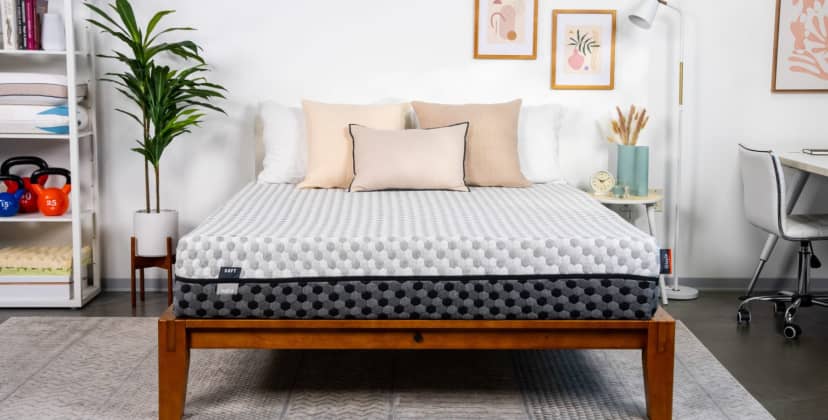
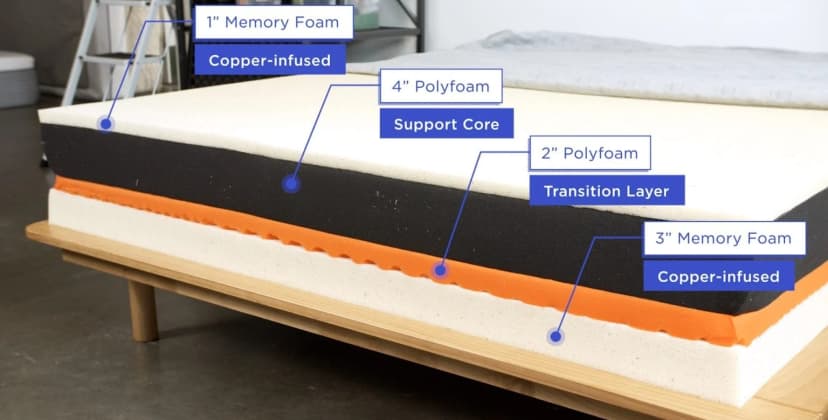
Credit: Sleep Foundation Test Lab
Price
$949
Mattress Type
Foam
Firmness Options
Medium Soft (4), Firm (7)
Trial Period
120 nights (4 week minimum)
At a Glance
- Who It’s Best For: Side sleepers (softer side) and back and stomach sleepers (firmer side).
- Feel: One side is firm (7) with only light contouring around your joints. The other is medium soft (4) and offers a deeper hug around the heavier parts of your body.
- What It’s Made Of: Memory foam infused with copper. Soft side also has a layer of responsive polyfoam. Support core in the middle is high-density polyfoam.
- What We Don’t Like: Single-side use may have a shorter lifespan compared to non-flippable models.
Scoring & Reviews
The following ratings show how suitable this mattress is for different sleeping positions and sleeper weights. These scores are determined by how well the mattress supports and relieves pressure for each sleeper type.
We performed a meta-analysis on 7558 validated customer reviews of the Layla Memory Foam Mattress. This is what people who bought the mattress had to say:- Dual Firmness Options: The Layla Memory Foam Mattress offers both soft and firm sides, allowing users to choose according to their comfort preferences, which is highly appreciated for accommodating different sleeping styles.
- Comfort and Support: Many reviewers have noted the mattress provides exceptional comfort, helping alleviate back pain and improving overall sleep quality. The soft side is often described as cloud-like, while the firm side offers adequate support without being too hard.
- Quality and Durability: Users report that the mattress maintains its shape and comfort over time, with no significant sagging or indentations, even after several years of use, indicating good durability.
- Temperature Regulation: The mattress is generally reviewed as doing a good job of regulating temperature, preventing overheating during sleep, which is a common issue with many memory foam mattresses.
- Ease of Setup: Customers appreciate the ease with which the mattress can be set up. It is delivered in a box and expands quickly once unpacked, making it convenient for immediate use.
- Customer Service: Layla’s customer service receives high praise for being responsive and helpful, aiding customers with issues ranging from delivery to product inquiries and returns.
Full Details
The Layla Mattress is reversible with a distinct feel on each side. The medium soft (4) side has thicker comfort layers that greatly relieve pressure for side sleepers and those with joint pain. Meanwhile, the firm (7) side offers an even sleep surface with slight contouring.
How It Performs
The two distinct feels appeal to different groups of sleepers. Our testers under 130 pounds found the softer side more comfortable, especially side sleepers. This side also performed well in the motion isolation category thanks to the thicker comfort layers.
Couples and co-sleepers who are easily disturbed by their partner’s movement should notice very few sleep interruptions. The firm side is better suited for back and stomach sleepers between 130 and 230 pounds.
Both sides outperformed many competing foam models in temperature regulation, but the firm side performs slightly better. This is largely due to the thinner comfort layers that retain less heat. The copper and gel infusions in the comfort layers are also meant to keep the foams cooler.
Construction Breakdown
The cover features proprietary cooling fabric made from a blend of polyester rayon, viscose, and poly/Lycra. Depending on the side you choose, the thickness of the comfort system varies. The softer side starts with a thick layer of copper and gel-infused memory foam, closely contouring the body.
Copper and gel infusions are engineered to absorb excess body heat and dissipate it. Next is a transitional layer of polyfoam. This layer is zoned to support heavier areas of the body while keeping weight evenly distributed to align the spine.
On the firmer side, the comfort system is thinner. This side has a layer of copper and gel-infused memory foam. Both sides share a support core made from dense polyfoam. This material limits sinkage and keeps the body on an even plane.
Trial, Shipping, & Warranty
Standard shipping is free to the contiguous U.S. The Layla Memory Foam Mattress comes with a 120-night sleep trial, and those who keep it receive a lifetime warranty against manufacturing defects.
Best Value Mattress
DreamCloud Classic Hybrid
8.5 /10
Test Lab Score
Up to 60% off mattresses + $599 in free sleep accessories
Up to 60% off mattresses + $599 in free sleep accessories
The DreamCloud Classic Hybrid is our pick for the best mattress for optimal comfort while resisting allergies. This thoughtfully designed hybrid gently supports the body, blending cushioning and bounce so that you can easily drift off to sleep.
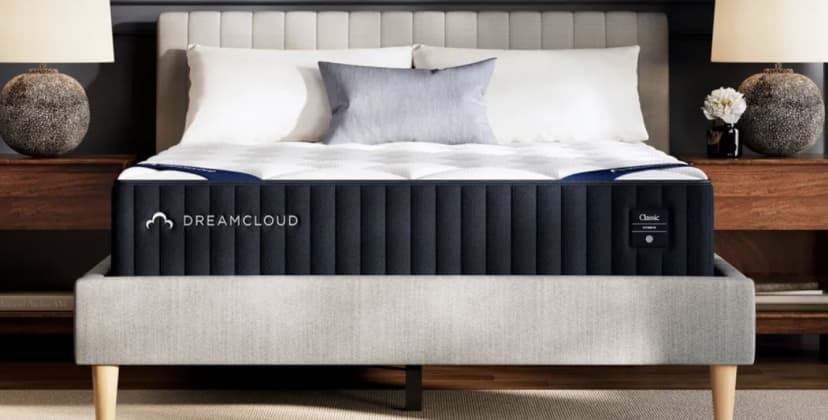
Credit: Sleep Foundation Test Lab
Price
$699
Mattress Type
Hybrid
Firmness Options
Medium Firm (6)
Trial Period
365 nights (30-night requirement)
At a Glance
- Who It’s Best For: Back and side sleepers under 230 pounds and stomach sleepers under 130 pounds.
- Feel: Medium firm (6). A comforting combination of springiness and contouring. Soft enough to be inviting but sturdy enough to be supportive.
- What It’s Made Of: Three layers of foams in the top, including memory foam and polyfoam. Underneath, pocketed coils rest on dense polyfoam. Cover is a stretch fabric blend quilted with cooling fibers.
- What We Don’t Like: Not supportive enough for stomach sleepers over 230 pounds.
Scoring & Reviews
The following ratings show how suitable this mattress is for different sleeping positions and sleeper weights. These scores are determined by how well the mattress supports and relieves pressure for each sleeper type.
We performed a meta-analysis on 8729 validated customer reviews of the DreamCloud Mattress. This is what people who bought the mattress had to say:- Comfort and Firmness: Many users describe the mattress as having a medium-firm feel that balances support and plushness, catering to various sleep positions.
- Motion Isolation: Couples appreciate the mattress’s ability to minimize motion transfer, allowing for undisturbed sleep even when sharing the bed with a partner. This quality is essential for those sensitive to movement during sleep.
- Pain Relief: Numerous customers report significant relief from back and joint pain, attributing this to the mattress’s supportive structure and pressure-relieving memory foam layers. This is consistent with expert recommendations for mattresses that promote spinal alignment.
- Temperature Regulation: The mattress’s cooling technology is frequently praised, with users noting a comfortable sleep temperature throughout the night. This feature is particularly beneficial for hot sleepers seeking a cooler sleep environment.
- Edge Support: Users mention strong edge support, providing confidence when sitting or sleeping near the mattress’s perimeter. This feature maximizes the usable sleep surface and enhances overall stability.
- Durability and Quality: Customers commend the high-quality materials and construction, expressing satisfaction with the mattress’s durability and longevity. The lifetime warranty further reinforces confidence in the product’s endurance.
- Customer Service and Trial Period: The 365-night trial period and responsive customer service are highlighted as significant advantages, providing peace of mind and flexibility during the purchasing process.
Full Details
The DreamCloud Classic Hybrid has a thoughtful design with four layers that work together to target back pain and provide comfortable pressure-relieving support.
People who experience back pain typically benefit from a mattress that offers both pressure relief and even support, and the DreamCloud Classic Hybrid delivers both. This medium firm (6) mattress has a hybrid design that features pocketed coils for responsive support and a foam comfort system that cradles your body.
How It Performs
A wide range of sleepers enjoyed this model during our in-house testing, with stomach, back, and side sleepers all giving it high marks. It also performed well during temperature trials. Hot sleepers should stay comfortable throughout the night thanks to the DreamCloud’s hybrid construction and gel-infused memory foam.
Construction Breakdown
The DreamCloud’s cover fabric is made from a supremely soft and stretchy fabric blend. A top layer of gel-infused memory foam contours closely to alleviate pressure buildup and draw heat away from the mattress.
A polyfoam transitional layer ensures that you don’t sink into the mattress core, which will be beneficial for those who prefer sleeping “on” rather than “in” a mattress.
The coils within the core are individually wrapped, which allows them to move freely from one another. This feature helps improve the mattress’ overall motion isolation. A thin layer of polyfoam anchors the mattress and provides a sturdy base.
Trial, Shipping, & Warranty
Shipping is free within the contiguous U.S. DreamCloud offers with a 365-night sleep trial with a 30-night break-in period. Each mattress is backed by a lifetime limited warranty.
Best Luxury Mattress
Zenhaven
8.7 /10
Test Lab Score
$300 off orders of $1,000 or more
$300 off orders of $1,000 or more
Attention-to-detail in every component of the Zenhaven mattress leads it to take home the top spot as the best luxury mattress for people with allergies. Its natural materials resist dust and mold, and its flippable design lets you pick which side best suits your sleep needs.
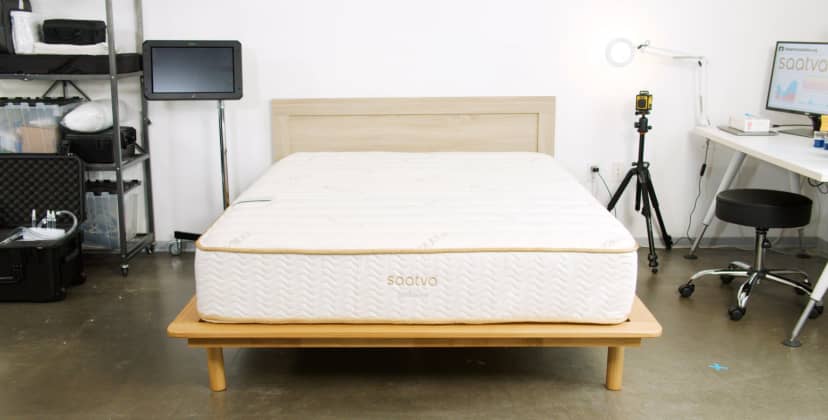
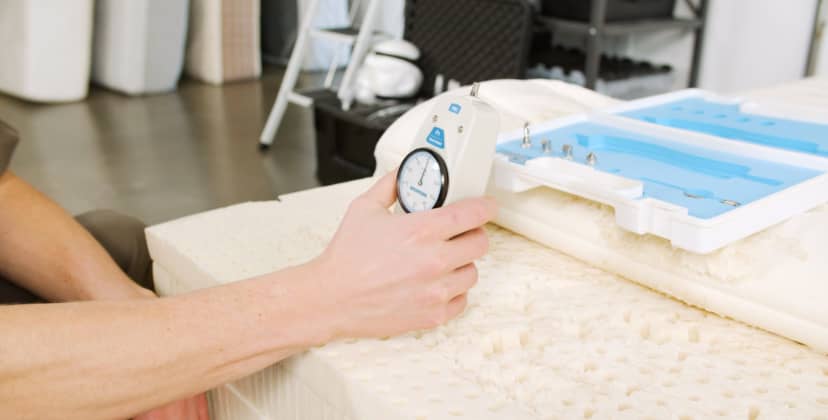
Credit: Sleep Foundation Test Lab
Price
$3,195
Mattress Type
Latex
Firmness Options
Medium Soft (4), Firm (7)
Trial Period
365 Nights ($99 Return Fee)
At a Glance
- Who It’s Best For: People who like the bounce of latex and eco-conscious shoppers.
- Feel: One side is medium soft (4), and the other side is firm (7). Both sides have responsive latex that keeps you from feeling stuck and that stays cool.
- What It’s Made Of: A combination of organic cotton, organic wool, and natural latex.
- What We Don’t Like: Not good for people with a latex allergy. Return fee of $99.
Scoring Breakdown
The following ratings show how suitable this mattress is for different sleeping positions and sleeper weights. These scores are determined by how well the mattress supports and relieves pressure for each sleeper type.
We performed a meta-analysis on 325 validated customer reviews of the Zenhaven. This is what people who bought the mattress had to say:- Latex Material: Many customers appreciate that the Zenhaven mattress is made from latex, which is supportive and durable. Several reviews mention the comfort and the hypoallergenic properties of the latex.
- Firmness Options: The Zenhaven mattress offers dual-sided firmness, allowing users to choose between a softer or firmer sleep experience. This feature is frequently highlighted as a significant benefit, accommodating different preferences for mattress firmness.
- Temperature Regulation: Multiple reviewers note that the Zenhaven mattress does not retain heat as much as other types, such as memory foam. This quality is particularly appreciated by those who tend to sleep hot.
- Customer Service: Zenhaven’s customer service is frequently praised for being helpful and responsive. The ease of the purchasing process and the professionalism during delivery are often highlighted.
- Weight and Handling: The mattress is noted to be heavy, making it challenging to move or flip without assistance. This could be a consideration for those who may need to relocate the mattress.
- Price Consideration: While some find the mattress to be an excellent investment, others mention it is on the pricier side. However, the quality and durability are often cited as justifying the cost.
Full Details
The Zenhaven mattress is designed with materials that are resistant to dust mites, mold, and microbes. The bed also does not include any known harsh chemicals in its construction, making it a great choice for people who are sensitive to certain allergens and chemicals.
How It Performs
The latex construction of the Zenhaven mattress makes it a durable mattress with plenty of edge support. The mattress regulates temperature, relieves pressure points, and facilitates movement. There is minimal off-gassing since it is made with all-natural materials.
Members of our testing team who weigh less than 130 pounds generally preferred the softer side. Those weighing 130 pounds or more received more support on the firmer side and found this surface more comfortable as a result.
Construction Breakdown
The flippable design of the Zenhaven mattress means sleepers can experience two different firmness options. The organic cotton cover of the Zenhaven mattress includes a 1-inch organic wool fire barrier on both sides. The combination of cotton and wool allows air to flow throughout the comfort system. These materials wick away moisture and help prevent the presence of mold and mildew.
The Zenhaven mattress is constructed with four layers of Dunlop latex. Each layer differs in firmness. The medium soft (4) side of the Zenhaven mattress has 1.5 inches of zoned latex above an additional 3 inches of latex. The firm side has 1.5 inches of firmer zoned latex and 3 inches of Dunlop latex for support. Pinholes in both comfort layers of latex create zones that are firmer beneath the torso and shoulders.
Trial, Shipping, & Warranty
Shipping is free within the contiguous U.S. Zenhaven offers a 365-night sleep trial, but returns are subject to a $99 return transportation fee. The mattress is covered by a lifetime warranty.
The company also offers a fairness replacement option beginning in year 3, meaning the customer can keep the original mattress and purchase a new one at a discounted price.
Best Mattress for Back Pain
WinkBeds EcoCloud
9.6 /10
Test Lab Score
30% off all WinkBeds mattresses
30% off all WinkBeds mattresses
The WinkBeds EcoCloud is our leading recommendation for a hypoallergenic mattress that helps minimize back pain. Its performance is powered by natural and eco-friendly materials that give targeted support to the joints and lower back.
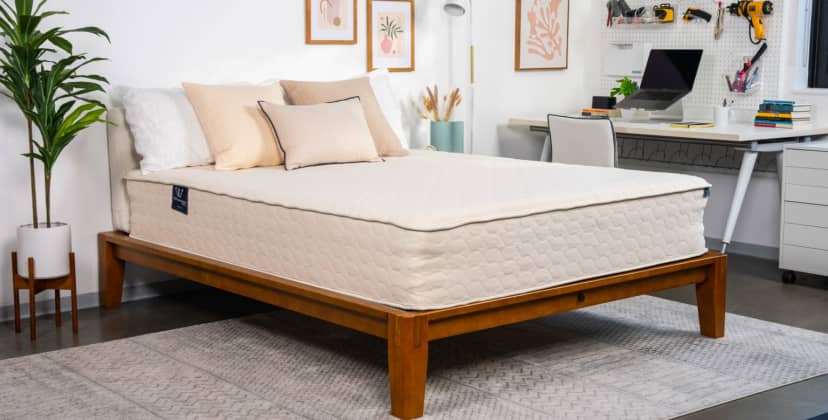
Credit: Sleep Foundation Test Lab
Price
$2,856
Mattress Type
Latex Hybrid
Firmness Options
Medium (5)
Trial Period
120 nights (30-night requirement)
At a Glance
- Who It’s Best For: Side and back sleepers under 230 pounds.
- Feel: Medium (5) with significant bounce and targeted support for hips, shoulders, and lumbar spine. Stays remarkably cool.
- What It’s Made Of: Cover is organic cotton and New Zealand wool. Comfort layer is 4 inches of responsive natural latex, and the support core is zoned pocketed coils that are reinforced around the perimeter.
- What We Don’t Like: On the expensive side. Some motion transfer.
Scoring & Reviews
The following ratings show how suitable this mattress is for different sleeping positions and sleeper weights. These scores are determined by how well the mattress supports and relieves pressure for each sleeper type.
We performed a meta-analysis on 249 validated customer reviews of the WinkBeds EcoCloud. This is what people who bought the mattress had to say:- Temperature Regulation: Several reviewers mention that the EcoCloud mattress has excellent temperature control, keeping them cool throughout the night, which is a significant advantage for those who tend to sleep hot.
- Eco-Friendly Materials: The use of biodegradable and natural materials in the EcoCloud mattress is frequently praised, making it a preferred choice for environmentally conscious consumers.
- Durability and Longevity: Users report that the mattress maintains its comfort and support over time, suggesting good durability and a worthwhile investment.
- Initial Adjustment Period: Some reviewers note a brief adjustment period, particularly when switching from a different type of mattress, but this is generally followed by improved sleep quality.
- Motion Isolation: The mattress is often described as having good motion isolation, meaning that movement from one side does not overly disturb a partner on the other side.
- Customer Service: Positive experiences with customer service are commonly highlighted, with mentions of helpful and responsive support throughout the purchasing and setup process.
Full Details
There are no synthetic foams used in the EcoCloud by WinkBeds. The mattress is made with natural materials, some of which are hypoallergenic. As a result, it is one of the best beds for people who have allergies to mildew, mold, and dust mites.
How It Performs
The hybrid construction of the EcoCloud mattress prevents the feeling of sleeping hot. Cotton, wool, and latex are all breathable materials and the coils add airflow to the mattress. This construction also allows for ample bounce and ease of movement.
The EcoCloud mattress has a medium (5) firmness that is good for most sleeping positions and body types. It is ideal for side and back sleepers. It may not be firm enough for stomach sleepers who weigh more than 230 pounds.
Construction Breakdown
The organic cotton and wool cover wicks away heat and moisture. This keeps the mattress clean and dry. Airflow is increased by the 4-inch layer of aerated Talalay latex.
This comfort layer is responsive and conforming, so it reduces tension throughout the body. It also creates an antibacterial surface for the mattress. The latex is zoned, so it is firmer underneath the lower back and lumbar region and softer under the shoulders and hips. The pocketed coil support base is also zoned for ergonomic support and pressure relief.
Trial, Shipping, & Warranty
Shipping is free for customers in the contiguous U.S. WinkBeds offers a 120-night sleep trial with a 30-night break-in period before a return can be initiated. Mattress purchases are covered by a lifetime warranty.
Best Mattress for Side Sleepers
Nolah Natural 11
8.9 /10
Test Lab Score
35% off sitewide + extra $100 off with code: SF100
35% off sitewide + extra $100 off with code: SF100
The Nolah Natural 11 earns the top spot for the best hypoallergenic mattress for side sleepers. It features organic and natural materials that not only fend off allergen buildup but also gently cushion the hips and shoulders for more comfortable side sleeping.
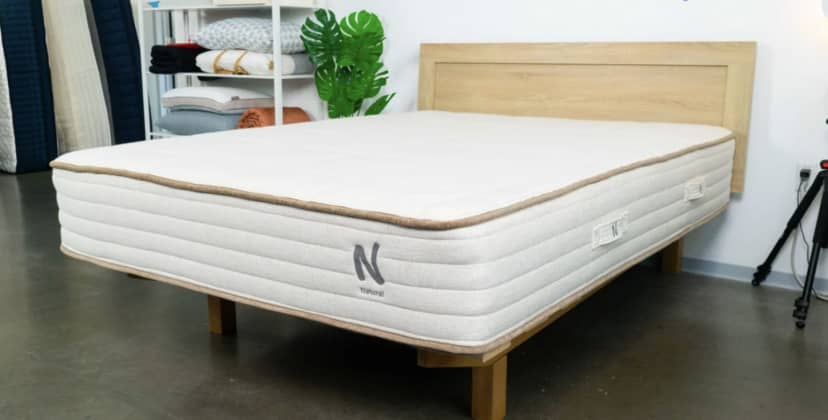
Credit: Sleep Foundation Test Lab
Price
$1,364
Mattress Type
Latex Hybrid
Firmness Options
Medium Firm (6)
Trial Period
120 nights
At a Glance
- Who It’s Best For: Side sleepers over 130 pounds and back and stomach sleepers under 230 pounds.
- Feel: Medium firm (6) that gently softens impact around the joints while ensuring cool sleep and easy movement.
- What It’s Made Of: The cover and outer layers are breathable organic cotton and wool. The top interior layers are natural latex on top of a tall layer of zoned innerspring coils.
- What We Don’t Like: Bounce may cause some motion transfer. Return fee of $99.
Scoring & Reviews
The following ratings show how suitable this mattress is for different sleeping positions and sleeper weights. These scores are determined by how well the mattress supports and relieves pressure for each sleeper type.
We performed a meta-analysis on 136 validated customer reviews of the Nolah Natural 11. This is what people who bought the mattress had to say:- Comfort and Support: Users frequently mention the Nolah Natural 11 mattress provides excellent comfort and support, helping alleviate back pain and improving sleep quality.
- Heat Retention Issues: Some reviewers have noted that despite claims of being temperature neutral, the mattress can retain heat, which has been a disappointment for those seeking a cooler sleep experience.
- Motion Isolation: The mattress is praised for its ability to isolate motion, allowing individuals to move without disturbing their partner, making it suitable for couples.
- Initial Off-Gassing: A few users reported a noticeable smell upon unpacking the mattress, although it typically dissipates after a few days.
- Firmness: Some customers have expressed concerns that the mattress is softer than advertised, particularly those who were expecting a firmer sleeping surface.
- Organic and Non-Toxic Materials: The mattress is highly rated for its use of organic, natural materials, which appeals to eco-conscious consumers and those sensitive to chemicals.
Full Details
The Nolah Natural 11 has a mid-range medium firm (6) feel and a highly supportive design, making it suitable for different sleeper types. That said, the even contouring and sturdy midsection support is particularly well-tuned to side sleeping.
How It Performs
The mattress excels at temperature control thanks to its breathable composition. The latex shouldn’t absorb as much body heat as foam and the coils promote consistent airflow throughout the interior.
Another cooling component is the cover made of organic cotton, as well as the layer of moisture-wicking wool that rests directly beneath the surface.
The latex also produces a noticeable bounce in response to movement. This allows you to get in and out of bed without feeling “stuck” in the mattress.
Construction Breakdown
A comfort layer of Talalay latex provides gentle cushioning and contouring for side sleepers who weigh at least 130 pounds, which helps align the spine and reduce pressure in the shoulders and hips.
The Natural 11’s robust coils are also zoned to provide extra reinforcement around the lower back and hips, so back and stomach sleepers who weigh up to 230 pounds can lie comfortably without sinking too much.
Trial, Shipping, & Warranty
Nolah provides free shipping in the contiguous U.S. The company offers a 120-night sleep trial, but customers can opt out of the trial period and lower the cost of their purchase. All orders come with a lifetime warranty against structural defects.
Best Mattress for Couples
Bear Elite Hybrid
8.5 /10
Test Lab Score
40% sitewide with code: SF40
40% sitewide with code: SF40
Couples love the performance of the Bear Elite Hybrid, which makes it the leading pick in this category. Its dense materials shut down space for allergens to collect, and its ability to contain vibrations helps ensure that movement on one side of the bed doesn’t disrupt a bed partner’s sleep.
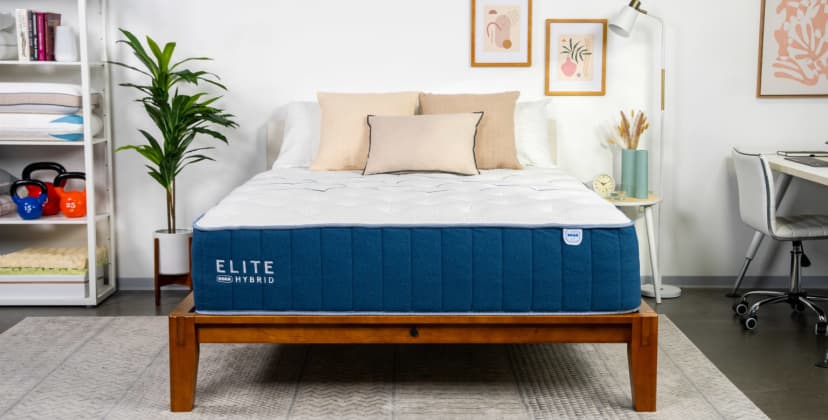
Credit: Sleep Foundation Test Lab
Price
$1,499
Mattress Type
Hybrid
Firmness Options
Medium (5), Medium Firm (6), Firm (8)
Trial Period
120 nights (30-night break-in period)
At a Glance
- Who It’s Best For: Wide range of people, particularly those who need zoned support and couples who value motion isolation.
- Feel: Varies between medium (5), medium firm (6), or firm (8) model. Dependable and comfortable, with targeted support under heavier areas.
- What It’s Made Of: A memory foam comfort layer infused with copper and bolstered by hypoallergenic and responsive polyfoam. Zoned coils and base polyfoam in the interior, and the cover is high-performance Celliant fabric.
- What We Don’t Like: A “new mattress smell” for a few days after unboxing. Many standard fitted sheets don’t fit.
Scoring Breakdown
The following ratings show how suitable this mattress is for different sleeping positions and sleeper weights. These scores are determined by how well the mattress supports and relieves pressure for each sleeper type.
We performed a meta-analysis on 3703 validated customer reviews of the Bear Elite Hybrid. This is what people who bought the mattress had to say:- Comfort and Support: Many reviewers highlight the mattress’s balance of comfort and support, often mentioning relief from back pain and improved sleep quality.
- Firmness Options: Customers appreciate the various firmness options, with some opting for firmer versions after experiencing discomfort with medium firmness.
- Temperature Regulation: Several reviews note the mattress’s ability to stay cool, which enhances sleep quality, especially in hot weather.
- Size and Upgrade Options: Customers are pleased with the availability of different sizes and the option to upgrade, which provides flexibility for different needs and preferences.
- Quality of Additional Products: Positive remarks on the quality of accompanying products like pillows and sheets, which are often included as free additions.
- Motion Isolation: Many reviewers highlight the mattress’s excellent motion isolation, making it ideal for shared sleeping arrangements.
Full Details
Couples often benefit from a mattress that absorbs movement transfer when one partner changes positions at night while offering a bouncy surface for sex. The Bear Elite Hybrid’s foam hybrid construction has a balanced feel for couples who don’t want to sacrifice responsiveness for motion isolation.
How It Performs
The Bear Elite Hybrid is available in three firmness options — medium (5), medium firm (6), and firm (8). The medium option earned the highest ratings from side and back sleepers up to 130 pounds, while the medium firm felt most comfortable to back sleepers up to 230 pounds and side sleepers up to 130 pounds. The firm performed best with back and stomach sleepers over 130 pounds.
The medium model excelled at motion isolation and pressure relief, thanks to the strong cushioning. The two firmer models performed well with temperature control, thanks to the breathable cover and steady airflow through the coils. Our hot sleepers felt comfortable throughout testing, and we detected minimal heat retention on the surface.
Construction Breakdown
The Bear Elite Hybrid mattress has a mixed-foam comfort system, starting with a memory foam layer underneath the quilted cover. This layer features a copper infusion meant to keep the surface cool to the touch. A transition layer of polyfoam prevents you from sinking too deeply into the mattress.
The support core of pocketed coils allows air to circulate throughout the mattress while reinforcing the sleep surface and creating a supportive perimeter. The coils are also zoned to enhance support to the lumbar region.
A layer of polyfoam supports the coils and adds durability to the mattress. A cover infused with Celliant and phase change material is engineered for enhanced nightly recovery, improved sleep quality, and temperature regulation.
Trial, Shipping, & Warranty
Shipping is free to the contiguous U.S. Mattresses come with a 120-night sleep trial with a 30-night break-in period before you can initiate a return. The mattress is covered by a lifetime warranty against structural defects.
Best Organic Mattress
Birch Mattress
8.8 /10
Test Lab Score
25% off sitewide
25% off sitewide
Our pick for the best organic and hypoallergenic mattress is the Birch Mattress. This latex hybrid uses organic and sustainable materials, keeps allergens from building up around your bed, and delivers an impressive level of all-around performance.
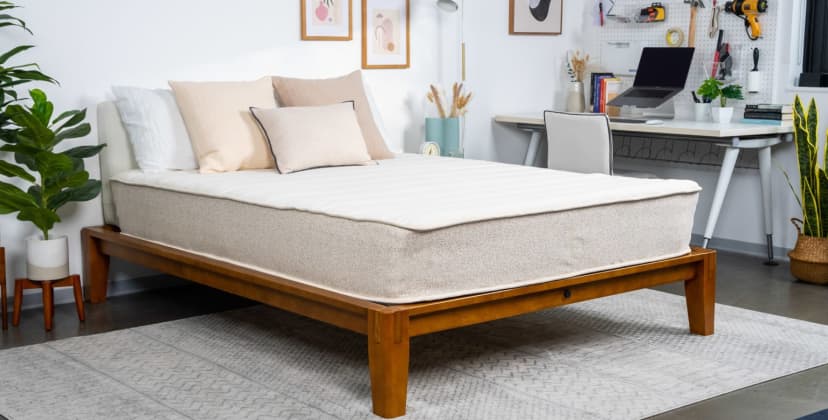
Credit: Sleep Foundation Test Lab
Price
$1,499
Mattress Type
Latex Hybrid
Firmness Options
Medium Firm (6)
Trial Period
120 nights (30-night requirement)
At a Glance
- Who It’s Best For: Side and back sleepers up to 230 pounds.
- Feel: Medium firm (6) and stays cool. Responsive and comfortable, with plenty of bounce and a surface that adapts to your weight.
- What It’s Made Of: Cover is organic cotton and organic wool. The top of the mattress is hypoallergenic organic latex, and the base is heavy-duty pocketed coils.
- What We Don’t Like: Too firm for side sleepers under 130 pounds. May notice motion transfer.
Scoring & Reviews
The following ratings show how suitable this mattress is for different sleeping positions and sleeper weights. These scores are determined by how well the mattress supports and relieves pressure for each sleeper type.
We performed a meta-analysis on 1917 validated customer reviews of the Birch Mattress. This is what people who bought the mattress had to say:- Comfort and Support: Many reviewers mention the mattress provides excellent support and comfort, particularly noting improvements in back and shoulder pain.
- Dual Firmness: The flippable design offering a choice between firm and soft sides is frequently appreciated, allowing users to customize their sleeping experience.
- Durability and Quality: Customers commend the high-quality, eco-friendly materials and construction, expressing satisfaction with the mattress’s durability and longevity. The use of organic and natural materials not only ensures comfort but also contributes to the mattress’s overall durability.
- Temperature Regulation: Customers appreciate the mattress’s ability to maintain a comfortable sleep temperature, attributing this to its natural and organic materials. The use of organic wool and natural latex contributes to effective temperature regulation, enhancing overall sleep quality. .
- Price: Opinions on the mattress’s price vary, with some finding it a good value and others considering it somewhat expensive.
- Weight and Maneuverability: The mattress is noted to be heavy, making it difficult to move or flip without assistance.
- Smell and Off-gassing: A few reviewers mention an initial off-gassing smell that dissipates over time.
- Edge Support: Mixed reviews on edge support, with some some noting it could be improved.
Full Details
The Birch Mattress is a great choice for sleepers with allergies who also prefer to buy and use sustainably sourced products. The materials in this mattress are also high-quality, and this helps ensure a long lifespan and good resistance to wear and tear.
How It Performs
Latex is naturally responsive, so owners can expect some bounciness when they get on and off the Birch Mattress. This may make the surface easier to move across for some people. A medium firm (6) feel makes the mattress best suited to people who weigh at least 130 pounds. Couples who enjoy springy surfaces for sex should also be satisfied.
Construction Breakdown
The comfort layer is composed of natural Talalay latex that has been certified by the eco-INSTITUT, indicating the material has been tested for chemicals that cause harmful emissions. The organic cotton cover has also been certified by the Global Organic Textile Standard.
Additionally, the top layer of wool batting has earned certification from the Wool Integrity NZ certification, ensuring the sheep used to obtain the wool are humanely treated.
The support core contains pocketed coils that stabilize the mattress and reinforce the sleep surface. Extra-strength coils along the perimeter minimize sinkage when you sleep near the edges of the mattress or get in and out of bed. The coils also promote steady airflow while the latex absorbs very little body heat, so the mattress should sleep fairly cool regardless of the current climate.
Trial, Shipping, & Warranty
The company offers free ground shipping to all 50 states. The mattress comes with a 120-night sleep trial that includes free returns. Those who opt to keep it also receive a lifetime manufacturer’s warranty
- Resistant to Dust Mites and Allergens: A hypoallergenic mattress should be made from materials like latex and dense memory foam that naturally resist dust mites, mold, and pet dander.
- Hypoallergenic Certifications: Some mattresses come with certifications like OEKO-TEX, GREENGUARD Gold, or CertiPUR-US, indicating that they’re free from harmful chemicals and allergens.
- Washable or Antimicrobial Covers: A removable, machine-washable cover makes it easier to remove allergens. And some covers are infused with antimicrobial treatments, like silver or copper, to prevent bacterial and fungal growth.
- Low VOC Emissions: Volatile organic compounds (VOCs) from synthetic foams and adhesives can cause respiratory irritation. A good hypoallergenic mattress should have low or no VOC emissions.
How We Evaluated & Reviewed
Meta Analysis: Of the 2,000+ mattresses in our product database, roughly 100 hold certifications such as GOTS, OEKO TEX Standard 100, and CertiPUR-US. Using historical testing data and construction analyses, our team chose the top 30 for additional in-depth evaluations.
Hands-On Testing: In our Seattle Test Lab, our team conducted a thorough analysis of each of the top 30 hypoallergenic models. We used cutting-edge tools and technology like a VOC meter to test off-gassing and a heat gun to evaluate temperature regulation.
Field Testing: Once we finished our lab tests, we sent each bed home with a member of our testing team to sleep on for up to two weeks to gauge how a mattress performs in real-world sleep environment.
User Reviews: We collected data from more than 28,000 verified customer reviews to determine whether our team’s findings match real-world experiences.
The Best Deals of the Week
-
Save $199
—
Brooklyn Bedding CopperFlex Memory Foam
$466 (List Price $665) -
Save $600
—
Helix Midnight Luxe
$1,799 (List Price $2,399) -
Save $2,436
—
Nectar Adjustable Bundle
$1,398 (List Price $3,834) -
Save $771
—
WinkBed
$1,799 (List Price $2,570) -
Save $1,020
—
DreamCloud Classic Hybrid
$699 (List Price $1,719)
Best Mattress Overall
Helix Midnight Luxe
9.7 /10
Test Lab Score
25% off sitewide
Shop at HelixA hybrid mattress that resists allergen buildup and delivers solid across-the-board performance.
See More Details
Best Foam Mattress
Layla Memory Foam Mattress
8.4 /10
Test Lab Score
Get an extra $10 off with exclusive code: sleepy10
Shop at LaylaLayla uses a reversible all-foam design and doesn’t break the bank.
See More Details
Best Value Mattress
DreamCloud Classic Hybrid
8.5 /10
Test Lab Score
Up to 60% off mattresses + $599 in free sleep accessories
Shop at DreamCloudThe DreamCloud is an exceptionally comfortable hybrid at a budget-friendly price.
See More Details

Credit: Sleep Foundation Test Lab
Best Luxury Mattress
Zenhaven
8.7 /10
Test Lab Score
$300 off orders of $1,000 or more
Shop at SaatvaA supportive luxury mattress made with natural and hypoallergenic materials.
See More Details

Credit: Sleep Foundation Test Lab
Best Mattress for Back Pain
WinkBeds EcoCloud
9.6 /10
Test Lab Score
30% off all WinkBeds mattresses
Shop at WinkBedsAn eco-friendly latex hybrid that provides essential spinal support.
See More Details
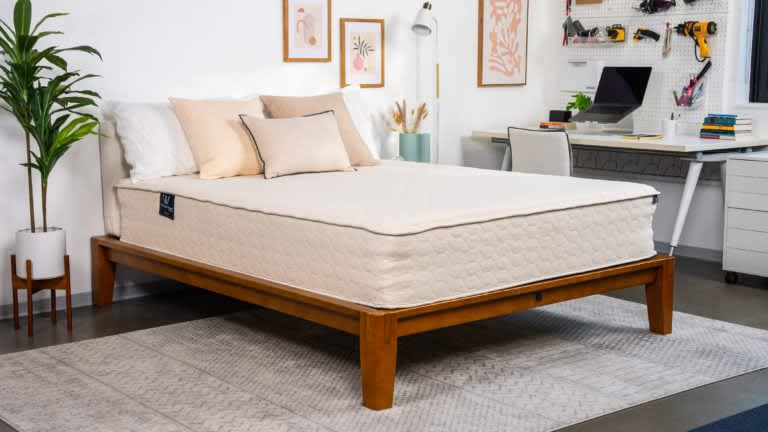
Credit: Sleep Foundation Test Lab
Best Mattress for Side Sleepers
Nolah Natural 11
8.9 /10
Test Lab Score
35% off sitewide + extra $100 off with code: SF100
Shop at NolahA hybrid built with sustainable materials that is perfect for side sleepers of all weights.
See More Details
Best Mattress for Couples
Bear Elite Hybrid
8.5 /10
Test Lab Score
40% sitewide with code: SF40
Shop at BearA mattress that serves couples by isolating motion while the concentration of allergens.
See More Details
Best Organic Mattress
Birch Mattress
8.8 /10
Test Lab Score
25% off sitewide
Shop at BirchThis bed stands out for its supportiveness and commitment to sustainability.
See More Details
How Does a Mattress Impact Allergies?
According to Dr. Audrey Wells, M.D., mattresses – especially those that are several years old – can be a hidden source of environmental allergens, including dust mites, pollen, mold spores, and animal dander. “Dust mites, in particular, are one of the most universal allergens found in mattresses,” says Dr. Wells. “These microscopic creatures thrive in warm, humid environments and feed on skin cells shed by people during sleep. Accumulation of their waste products and body parts can trigger sneezing, nasal congestion, itchy eyes, and even asthma symptoms.”
What Type of Mattress Is Best for Allergies?
The following mattress types are the ones most commonly found in today’s market. Each mattress type has benefits for allergy sufferers, though some are better suited than others. Allergy sufferers should keep the quality of materials and overall construction in mind when shopping for a mattress.
Dr. Wells also notes mold can also develop in mattresses, especially in environments with high humidity levels or if a mattress is not properly ventilated after use. Pet-related allergens and pollen are other potential issues. “Pet owners may unknowingly contribute to the allergen load in their mattresses by letting their furry family member on the bed,” says Dr. Wells. “Pet dander and hair can embed deeply into the fabric and foam on a mattress. Even pollen from outside can find its way onto bedding and into the mattress, compounding the allergenic environment.”
Hybrid
Definition: A hybrid mattress has an innerspring support core. The coils are typically pocketed to reduce motion transfer and allow for better responsiveness. Some have a dual coil construction with a transition layer of micro coils. Above the support core is usually a thick comfort system of foam or latex. Hybrid mattresses incorporate the benefits of foam, latex, and/or innerspring mattresses while minimizing any negatives.
Highlight: Allergen-resistant comfort systems. The thick comfort systems of hybrid mattresses are often made of materials that resist common allergens. Many hybrid mattresses have layers of latex or memory foam that resist dust mites, mildew, and mold.
Innerspring
Definition: An innerspring mattress has a coil support core that makes up most of the mattress, with thin comfort layers of fiber or padding. This traditional model is somewhat outdated, but updated versions utilize pocket coils and hypoallergenic comfort layers. Allergy sufferers should be wary of open coil designs and fibrous padding because these can support the growth of dust mites. A protective mattress cover can help.
Highlight: Affordable pricing. Innerspring mattresses are often budget-friendly, as the simple design means a lower price point. This makes it easier to replace the mattress every few years, especially if the coils begin to sag or allergens build up within the support core.
Latex
Definition: A latex mattress is made entirely of latex. The construction can include multiple layers, which may consist of natural, synthetic, or blended latex. Natural latex is harvested sap from rubber trees, which is processed using either the Dunlop or Talalay method. Dunlop latex is dense and durable, so it’s often used in the support core of latex mattresses. Talalay latex requires additional processing that results in a softer, lighter feel. This makes it ideal for comfort layers.
Highlight: Allergen-resistant. Latex is a breathable material, which keeps moisture from building up. This helps it resist mold and mildew. Latex is also resistant to dust mites. Those with latex allergies should exercise caution, though many natural latex mattresses are processed in a way that removes certain latex proteins that trigger allergies.
Airbed
Definition: An airbed mattress has a support core comprised of an air-filled chamber. A built-in pump adjusts the amount of air in the chamber, which changes the overall firmness of the mattress. This allows for a customized feel. Some airbeds have dual chambers, so couples can adjust each side individually. The comfort layers of an airbed can include foam, latex, or other materials.
Highlight: Resistant to dust mites. The sealed air chamber of an airbed mattress is not a conducive environment for dust mites. Many airbeds also use hypoallergenic materials in the comfort layers.
Foam
Definition: A foam mattress is constructed with multiple foam layers, which may include memory foam or polyfoam. Memory foam is a viscoelastic foam that relieves pressure and conforms closely, so it’s often used in comfort layers. Polyfoam can be used in comfort or support layers. The core of a foam mattress is usually a high-density polyfoam for added durability.
Highlight: Resistant to allergen buildup. Many foam mattresses resist common allergens, and memory foam is generally considered to be allergen-resistant. Dense foam, in general, is not a conducive environment for dust mites.
How to Choose a Mattress for Allergies
There are multiple factors to consider when mattress shopping. Allergy sufferers need symptom relief and a mattress that promotes rest and recovery. Getting better sleep means an improved quality of life. Important considerations are outlined in the following section, including what to look for in a mattress. Keep in mind that allergies affect people in different ways, so unique needs and preferences should be taken into consideration as well.
- Price: A high-quality mattress is an investment. Mattresses can cost anywhere from $500 to $2,500 or more. Purchasing a high-quality mattress may mean you spend more initially, but you will not need to replace your mattress for a long time. Price is affected by multiple factors, including the quality of materials, construction, and workmanship involved. Certain materials that are better for allergy sufferers, like natural latex and plant-based foams, tend to be more expensive.
- Quality Materials: The quality of the materials used in a mattress affect more than just price. They also determine the lifespan of the mattress and contribute to how supportive and comfortable the mattress is. On average, the lifespan of a mattress is six to eight years, though some can offer consistent support for ten years or longer. For allergy sufferers, high-quality materials that resist allergens can reduce exposure and relieve symptoms. This includes organic and natural materials like cotton, wool, and latex.
- Firmness Level: Mattress firmness is rated on a scale of 1 to 10, or extremely soft to extremely firm. Most mattresses tend to fall closer to the middle of the scale, from medium soft (4) to firm (7-8). The right firmness for each person will depend on sleeping position, weight, and other preferences. Those who prefer to sink into their mattresses will often choose a soft to medium soft mattress, while those who want a balance of conforming and support opt for a medium to medium firm choice.
- Pressure Relief: Depending on your sleeping position, pressure can build up in areas like the shoulders, back, and hips. A mattress that provides pressure relief contours to the shape of the body and cushions these areas. This relieves pressure and tension and reduces aches and pains. For allergy sufferers, this can improve overall sleep quality and result in one less thing to worry about.
- Edge Support: Edge support refers to how the perimeter of the mattress responds to pressure. A mattress with top-notch edge support prevents sagging over time. It also helps sleepers feel supported near the edge of the mattress and makes it easier to get in and out of bed. For couples, it increases the usable surface area of the mattress. Hybrid mattresses typically have reinforced perimeters and ample edge support, while foam mattresses are more likely to sink in or sag along the edges when compressed.
- Contouring: Contouring indicates how well the mattress conforms to the shape of the body. This affects pressure relief, as a conforming mattress will cushion pressure points and reduce tension. It can also affect temperature regulation. A mattress that conforms closely can restrict airflow around the body and retain heat. Memory foam is known for its conforming properties and “body-hugging” feel. Latex contours moderately for pressure relief and better temperature regulation.
- Temperature Regulation: Overheating while sleeping can cause discomfort, especially for allergy sufferers. If a mattress sleeps hot, there is a greater likelihood of sweat and moisture building up in the mattress. This can encourage the growth of mold and mildew, which is not ideal for those with allergies. Natural materials like wool and cotton wick away heat and moisture, and certain mattresses are better at regulating temperature than others.
- Ease of Movement: How easy it is to move around on a mattress is determined by how resilient the mattress layers are. This measures how quickly the materials return to their original shape when pressure is removed. Ease of movement is an important consideration for couples during intimate activity. It is also essential for combination sleepers who shift positions throughout the night, as it prevents feeling restricted. However, ease of movement can translate to greater motion transfer, which may cause sleep disturbances for those who share the bed with a partner.
- Mattress Type: There are five common mattress types, which we’ll cover in-depth in the next section. These include hybrid, innerspring, foam, latex, and airbed mattresses. Certain mattress types are more beneficial for allergy sufferers than others. Latex, memory foam, and hybrid mattresses often resist common allergens and provide relief for people with certain allergies.
How Can Your Bedding Impact Your Allergies?
Bedding can be a main culprit of allergens in the bedroom, especially dust mites. Choosing the right bedding and washing it every week or two in hot water can reduce exposure to allergens. While hypoallergenic bedding may not significantly reduce symptoms, it’s one measure you can take to improve your bedroom environment.
Your pillow is another important consideration. “Pillows are in direct contact with your face and head, making them prone to collecting skin cells, sweat, oils, and hair products,” says Dr. Wells. “They are also a prime habitat for dust mites but may hold a smaller total volume of allergens due to their size. The frequent contact with your mouth and nose can lead to a higher likelihood of inhaling these allergens directly. Unlike mattresses, pillows may also absorb more body oils and saliva, potentially supporting bacterial and fungal growth.”
Dr. Wells adds that mattresses and pillows should both be regularly cleaned or protected with allergen-proof covers to minimize exposure and promote a healthier sleep environment. Replacing pillows more frequently than mattresses is also advisable due to their smaller size and proximity to the face.
What Type of Bedding Is Best for Allergies?
Hypoallergenic bedding is often tightly woven to prevent dust mites and other allergens from inhabiting the fabric. Natural materials like bamboo, cotton, silk, wool, and linen also resist dust mites, mold, and mildew. These fabrics are lightweight and breathable, which helps dissipate any moisture in the bedding.
In addition to sheets and duvets or comforters, be careful when choosing your pillows. Some of the best pillows for allergies are latex and foam pillows because they resist dust mites and other allergens. Investing in breathable pillowcases that wick away heat and moisture can provide additional comfort.
Also look for bedding that’s easy to clean. Whether or not your bedding is hypoallergenic, washing it regularly will help prevent allergens from building up. Wash all bedding at least once a week. Using hot water and high heat should kill dust mites, but double-check any care instructions.
What Type of Bedding Should I Avoid if I Have Allergies?
Certain types of bedding can irritate allergies. Some have found that down-filled bedding retains moisture and exacerbates allergy symptoms. Loosely woven bedding, or comforters and pillows with a loose fiberfill, may support the growth of dust mites.
Synthetic materials that use harsh chemicals should be avoided if you have chemical sensitivities. These materials are often less breathable, too. The more moisture your bedding retains, the more likely it is to facilitate the growth of mold and mildew. Bedding that must be professionally cleaned should be avoided, unless you regularly visit the dry cleaner.
How We Test: Your Comfort Is Our Science
Our industry-leading product testing team cares deeply about improving your sleep. Having a holistic understanding of a mattress’s role as part of a sleep system is paramount to our testing process. Since a bed’s comfort and feel depend largely on body weight and sleeping position, our testing team represents a wide range of body types, sleep positions, and comfort preferences.
In our Seattle-based Test Lab, we use an objective, hands-on process to evaluate mattresses across performance categories. The following are the key guidelines that inform our performance ratings. Our ultimate goal is to ensure you have all the information you need to make the best purchase decision for you.
Construction analysis: Testing begins with a thorough examination of the mattress in terms of physical construction. We note materials, firmness, thickness, and other factors that play a role in durability and overall comfort. We also weigh the mattress’s price against the quality of its materials and design.
Product testing: Hands-on evaluations are conducted in our Seattle Test Lab. We take turns lying and moving on each mattress to assess performance categories like pressure relief, motion isolation, edge support, and temperature control.
Field testing: After we’ve concluded our in-house evaluations, one of our testers will take the mattress home and sleep on it in their own bedroom for several weeks. Their daily notes and overall experience with the mattress helps us determine how well it will perform in the long term.
User testing: We read feedback from verified mattress owners in customer surveys and product reviews. We may adjust out initial ratings if we feel they aren’t reflective of real-world experiences.
How We Determine Our Overall Scores


To determine a mattress’s overall score, we assign weighted percentages to performance categories based on how important they are to the individual sleep experience. For instance, areas like pressure relief and temperature control tend to matter more to people than something like off-gassing, and because more people sleep on their side and back than on their stomach, we weigh those positions more heavily.
Performance Categories
Motion Isolation
This criteria alludes to the amount of motion a mattress absorbs when a sleeper moves on the surface. We use two testers lying side by side to evaluate motion isolation, who each feel for transfer while the other person moves on the mattress.
Temperature Control
To determine how well a mattress regulates temperature, we perform temperature tests and look closely at its materials and construction. Many mattresses are designed with cooling components meant to reduce heat retention.
Pressure Relief
A bed with strong pressure relief excels at preventing pressure from building up in areas like the shoulders and hips. Beds with even contouring and weight distribution are top performers when it comes to pressure relief.
Off-Gassing
A mattress in a box may release unpleasant chemical odors for a short period after you’ve unboxed it. The initial smell may be strong but typically fades within 2 or 3 days.
Ease of Movement
This criteria reflects how easily a sleeper can move across a bed’s surface. Responsive surfaces made of latex typically perform better than foam surfaces, which can inhibit movement.
Edge Support
We perform sit tests along a bed’s perimeter to measure how well the edges push back against weight. Mattresses with strong edge support have minimal sagging when sleepers sit on or lie close to the perimeter.
Dive Deeper – In-Depth Mattress Guides
For more help deciding which mattress is right for you, take a look at our recommendations broken down by mattresses that relieve specific pain points.
Best Mattress by Specific Purpose
Frequently Asked Questions
How Can I Get Allergy Relief on a Budget?
For shoppers on a budget, buying a new mattress may not be in the cards just yet. Or, if you recently bought a mattress but want to take additional measures without overspending, you may be wondering how to get allergy relief on a budget. In these situations, a mattress protector is worth considering.
Mattress protectors encase the entire mattress and protect against dust mites and other allergens. Hypoallergenic mattress protectors are good for mattresses like innerspring models that can be more prone to dust mite infestations. Waterproof mattress protectors keep moisture out and prevent mold and mildew. These measures can help reduce the buildup of allergens, but may not have as much impact on symptoms.
Are Hypoallergenic Mattresses Worth It?
According to Dr. Wells, mattress selection is often necessary for people with allergies to get a good night’s rest. Allergy sufferers may benefit from a mattress made from hypoallergenic materials, like latex or memory foam, because these materials resist allergen buildup and promote a healthier sleep environment,” she says. “Their dense structure limits dust mites, while natural antimicrobial properties reduce mold and mildew. Many hypoallergenic mattresses also feature allergen-blocking covers and low-emission materials, minimizing exposure to irritants for those who are sensitive. They can be easier to clean and maintain. For long-term relief, pairing such a mattress with an allergen-proof cover and regular cleaning is effective.”
How Much of an Investment Do I Need to Make?
When considering how much of an investment you’ll need to make, first determine whether your bedroom needs small changes or an entire revamp. Take into consideration how severe your allergy symptoms are, and if they worsen in the bedroom. This will help you determine if you just need to make small changes, like switching to hypoallergenic bedding, or big changes, like switching from carpet to hardwood floors and purchasing a new mattress.
Dr. Wells also recommends showering and washing your hair before bed, especially when the pollen count is high. Flushing your nasal passages with a saline rinse is another option. “Nasal congestion can worsen when transitioning from an upright to a lying-down position due to changes in blood flow, gravity, mucus clearance and fluid dynamics in the nasal passages,” says Dr. Wells. “The nasal environment is dynamic, and changes with position are normal to a certain extent. However, these changes can be especially prominent on top of allergy symptoms. Use of topical nasal steroids can help.”
On average, a high-quality mattress with hypoallergenic properties may cost around $1,500. New bedding and a mattress protector will add to the overall investment. Those who need additional relief can consider an air purifier and/or a dehumidifier for the bedroom. There are always budget-friendly and luxury options available, so set a budget that is comfortable for you.

Still have questions? Ask our community!
Join our Sleep Care Community — a trusted hub of product specialists, sleep health professionals, and people just like you. Whether you’re searching for the perfect mattress or need expert sleep advice, we’ve got you covered. Get personalized guidance from the experts who know sleep best.

